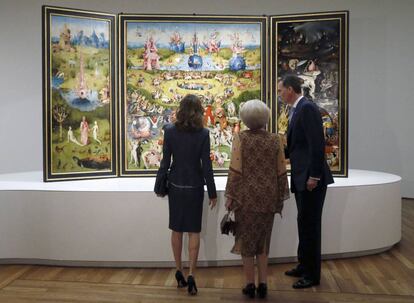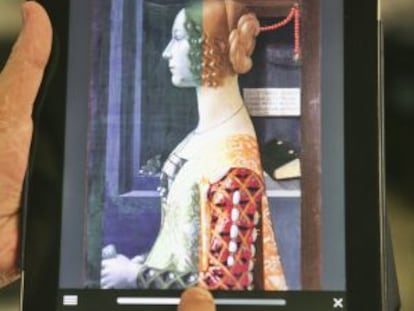The fantastical world of Bosch is the Prado’s exhibition of the year
‘The Garden of Earthly Delights’ is the high point of this celebration of the Dutch master in Madrid

Few works of art have fascinated and enthralled over the centuries as much as Hieronymus Bosch’s The Garden of Earthly Delights. One of the highlights of Madrid’s Prado art museum, it is a fantastical depiction of medieval sexuality awash with tiny characters swarming across the two-meter-high triptych. Such is the depth and scope of the detail that weeks of careful scrutiny would be needed to discover and fully appreciate its myriad elements. Naked men and women are depicted fornicating, drinking and fighting: the masterpiece portrays a world of sin and the inevitable damnation that awaits them. It is an extraordinary painting filled with elusive allegories, retaining the power to inspire many of the 20th century Surrealists and today, some say, even the TV series Game of Thrones.
A contemporary of Leonardo da Vinci, Bosch’s work was also revolutionary, depicting humanity’s deepest desires and fears in graphic detail
Entitled El Bosco, an exhibition at the Prado commemorating the 500th anniversary of Bosch’s death offers new insight into the work of the Dutch master, curated by Pilar Silva Maroto with the help of the Brabante de Hertogenbosch Museum in Den Bosch, the painter’s birthplace.
Set to run until September 31, the exhibition is one of the most ambitious to date of Bosch’s work, much of which was long considered too scandalous to be shown. Among the 50 paintings, some of them lent by other museums for the occasion, is The Temptation of St Anthony from Lisbon’s National Museum of Ancient Art. Others are from the Prado’s own collection and include The Adoration of the Magi and another triptych, The Haywain.
Exploring humanity’s fears and desires
Bosch, who lived between 1450 and 1516, never traveled far beyond his hometown, though this did not limit either his imagination or his influence on the international art scene. A contemporary of Leonardo da Vinci, Bosch’s work was also revolutionary, depicting humanity’s deepest desires and fears in graphic detail. Spanish historian Francisco Calvo Serraller explains that the key to understanding the artist is to put him in the context of events happening in the late 15th and early 16th century, one of the most turbulent periods of Western history.

Bosch was already aged 42 when Columbus arrived in the Americas, an extraordinary event that undoubtedly changed his perception of reality. “The feeling that the planet was being mapped out anew, the sudden appearance of a new world, of new flora and fauna and an unknown race of people really shook Europe up in the wake of the print revolution, which allowed these discoveries to be quickly broadcast, ushering in the winds of reform,” says Calvo Serraller.
Bosch was able to depict concepts and narratives using iconography infused with imagination, earning him acclaim far and wide. In Spain, the first art connoisseur to collect his work was Felipe de Guevara, a member of the court of Charles V. Guevara defined Bosch’s work as “a very instructive world of chimeras and fantasies.”
‘The Garden of Earthly Delights’ portrays a world of sin and the inevitable damnation that awaits
Later, Phillip II acquired a number of his paintings, which he reportedly treasured for the way they depicted the human soul. In fact, it is thanks to his popularity among the Spanish monarchy that the Prado and the monastery in Phillip’s monastery at El Escorial now hold so many of his works.
Uncertain of the chronological order in which Bosch produced his work, the Prado has organized the exhibition into five categories: The New Testament, The World and its Final Moments, The Profane Works, The Saints and The Drawings. Additionally, some of the technical work produced by the Bosch Research and Conservation Project, which has used methods such as infrared reflectography to study the condition of his paintings in depth, can also be seen.
English version by Heather Galloway.
Sign up for our newsletter
EL PAÍS English Edition has launched a weekly newsletter. Sign up today to receive a selection of our best stories in your inbox every Saturday morning. For full details about how to subscribe, click here.
Tu suscripción se está usando en otro dispositivo
¿Quieres añadir otro usuario a tu suscripción?
Si continúas leyendo en este dispositivo, no se podrá leer en el otro.
FlechaTu suscripción se está usando en otro dispositivo y solo puedes acceder a EL PAÍS desde un dispositivo a la vez.
Si quieres compartir tu cuenta, cambia tu suscripción a la modalidad Premium, así podrás añadir otro usuario. Cada uno accederá con su propia cuenta de email, lo que os permitirá personalizar vuestra experiencia en EL PAÍS.
¿Tienes una suscripción de empresa? Accede aquí para contratar más cuentas.
En el caso de no saber quién está usando tu cuenta, te recomendamos cambiar tu contraseña aquí.
Si decides continuar compartiendo tu cuenta, este mensaje se mostrará en tu dispositivo y en el de la otra persona que está usando tu cuenta de forma indefinida, afectando a tu experiencia de lectura. Puedes consultar aquí los términos y condiciones de la suscripción digital.
More information
Últimas noticias
Most viewed
- Alain Aspect, Nobel laureate in physics: ‘Einstein was so smart that he would have had to recognize quantum entanglement’
- David King, chemist: ‘There are scientists studying how to cool the planet; nobody should stop these experiments from happening’
- Maps of the US attack on Venezuela: Targets, airspace and deployed fleet
- Key points of the military attack on Venezuela: Early morning bombings and a ‘captured’ president
- World reactions to the US strikes on Venezuela










































